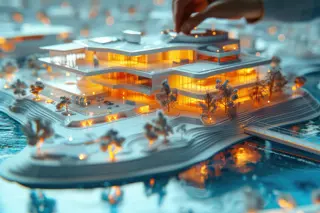New Delhi's First 3D-Printed Housing Project: Changing Affordable Housing with Cutting-Edge Tech
 A Leading Developer Breaks Construction Barriers
A prominent real estate developer has unveiled New Delhi's first 3D-printed housing development, set to start construction in July 2025. This innovative project aims to transform urban housing with advanced construction technology, aiming for 70% faster build times and 30% cost reductions compared to traditional methods.
A Leading Developer Breaks Construction Barriers
A prominent real estate developer has unveiled New Delhi's first 3D-printed housing development, set to start construction in July 2025. This innovative project aims to transform urban housing with advanced construction technology, aiming for 70% faster build times and 30% cost reductions compared to traditional methods.
Why This Project Matters
- Addresses critical housing shortages in India's capital through rapid production
- Aligns with Smart Cities Mission goals for sustainable urban development
- Shows better solutions for affordable residential projects
3D Printing in Construction: How It Works
The development will use industrial-scale 3D printers to extrude specially formulated concrete in layered fashion, creating structurally sound walls with minimal waste. Unlike traditional methods:
- Customizable designs: Complex geometries and curved features possible to utilise space
- Integrated voids: Hollow spaces accommodate plumbing/wiring during construction
- Reduced material use: Precision-controlled concrete deposition
Key Advantages Over Traditional Methods
| Aspect | Traditional | 3D-Printed |
|---|---|---|
| Construction Time | 6-12 months | 1.8-3.6 months |
| Labor Costs | High | Moderately Low |
| Material Waste | 10-15% | <5% |
| Design Flexibility | Limited | Unrestricted |
| Energy Efficiency | Moderate | High (thick insulated walls) |
Project Overview
Location: The development will target peripheral growth zones in New Delhi, leveraging available land while maintaining proximity to infrastructure. Phases:
- Pilot Phase (2025): Completed units for initial occupancy
- Expansion Phase (2026): Scalable neighborhood complex
- Tech Hub Integration: Collaborations with IITs/startups for material R&D
Collaborations: Anticipated partnerships with government housing authorities and architectural-tech firms to refine sustainable designs.
The Bigger Picture
While New Delhi's project follows successful implementations in Pune and Chennai, its scale and location position it as a national prototype. Successful execution could:
- Reduce urban migration pressures through rapid housing supply
- Demonstrate replicable models for other metros
- Attract global investment in Indian prop-tech
Challenges to Address
- Regulatory Frameworks: Navigating building code compliance for new materials
- Material Limitations: Seasonal temperature constraints for concrete curing
- Public Perception: Overcoming resistance to 'printed' homes
Conclusion
This bold initiative signals India's growing role in construction innovation, offering tangible solutions to urbanization challenges. As Mumbai, Bengaluru, and other cities watch closely, New Delhi stands poised to redefine affordable housing standards through this disruptive technology.